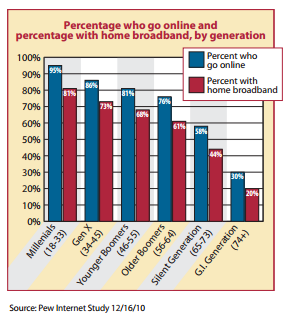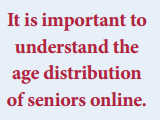According to the Pew Internet American Life Project, the majority of U.S. adults over the age of 65 are now online. While many nonprofits have utilized websites for a number of years, and many of those include specialized planned giving content, we are just now entering a time when we can expect that the majority of the 65-plus population may be able to access online gift planning tools.
Although seniors are still less likely to go online than middle-aged or younger people, this news represents a tipping point from a gift planner’s perspective. The number of seniors online will grow dramatically over the next decade as growing numbers of baby boomers celebrate their 65th birthdays.
Which seniors are online?
It is important to understand the age distribution of seniors online. There appears to be a digital divide in Internet usage between those 65 to 73, where 58 percent are online, and the 74-plus group where the number online drops to 30 percent. It is also important to note that 44 percent of the “younger old” access the Internet via broadband, while just 20 percent of the 74-plus group have broadband service. Pew reports that the drop-off in use by those over 74 is due to a number of factors, not the least of which are physical limitations coupled with visual and auditory challenges.

Those responsible for marketing gift annuities, for example, should keep in mind that according to the American Council on Gift Annuities, some 82 percent of gift annuitants with immediate payment gift annuities are over the age of 75. Based on the Pew data, just 30 percent of prospective gift annuitants can be reached online and just 20 percent are able to easily view videos and use other broadband-intensive tools.
The same would be true of efforts to encourage bequests, where Sharpe studies of the majority of leading bequest programs in America indicate the average age at completion of wills where funds are actually received at the death of the donor is 79.
Well-managed gift planning marketing efforts will, as a result, continue to rely primarily on print and other non-web based communication strategies to reach the vitally important 75-plus age group. In fact, more than one large planned giving program has traced a drop in gift annuity and bequest activity to neglect of print marketing for five years or longer.

Reaching your potential audience
The popularity of Internet use among younger seniors may well dictate the development of senior communication strategies designed to maximize the effectiveness of various Internet-based gift planning tools. The ongoing emergence and convergence of technology are likely to influence the way we deal with older donors today and in the future. For example, 70 percent of those 65 and older have cell phones, and growing numbers are purchasing various tablets or iPads that will enable them to stay connected on the go.
If you are unsure whether your existing online gift planning content is reaching the right audience, or if you are considering how to enhance your online gift planning capabilities, visit sharpenet.com or contact us for more information.

